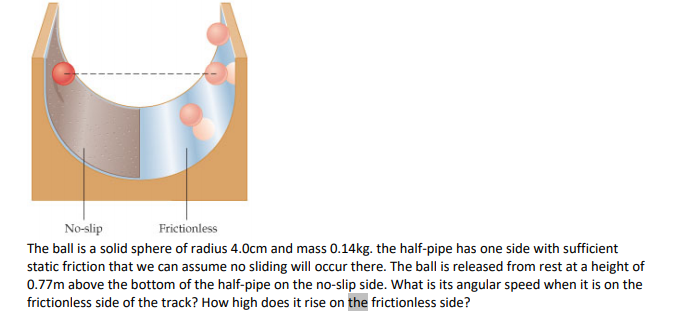No-slip Frictionless The ball is a solid sphere of radius 4.0cm and mass 0.14kg. the half-pipe has one side with sufficient static friction that we can assume no sliding will occur there. The ball is released from rest at a height of 0.77m above the bottom of the half-pipe on the no-slip side. What is its angular speed when it is on the frictionless side of the track? How high does it rise on the frictionless side?
No-slip Frictionless The ball is a solid sphere of radius 4.0cm and mass 0.14kg. the half-pipe has one side with sufficient static friction that we can assume no sliding will occur there. The ball is released from rest at a height of 0.77m above the bottom of the half-pipe on the no-slip side. What is its angular speed when it is on the frictionless side of the track? How high does it rise on the frictionless side?
University Physics Volume 1
18th Edition
ISBN:9781938168277
Author:William Moebs, Samuel J. Ling, Jeff Sanny
Publisher:William Moebs, Samuel J. Ling, Jeff Sanny
Chapter11: Angular Momentum
Section: Chapter Questions
Problem 50P: A roller coaster has mass 3000.0 kg and needs to make it safely through a vertical circular loop of...
Related questions
Concept explainers
Angular speed, acceleration and displacement
Angular acceleration is defined as the rate of change in angular velocity with respect to time. It has both magnitude and direction. So, it is a vector quantity.
Angular Position
Before diving into angular position, one should understand the basics of position and its importance along with usage in day-to-day life. When one talks of position, it’s always relative with respect to some other object. For example, position of earth with respect to sun, position of school with respect to house, etc. Angular position is the rotational analogue of linear position.
Question
1-

Transcribed Image Text:No-slip
Frictionless
The ball is a solid sphere of radius 4.0cm and mass 0.14kg. the half-pipe has one side with sufficient
static friction that we can assume no sliding will occur there. The ball is released from rest at a height of
0.77m above the bottom of the half-pipe on the no-slip side. What is its angular speed when it is on the
frictionless side of the track? How high does it rise on the frictionless side?

Transcribed Image Text:1) Draw a pictorial representation of the problem.
2) List given information.
3) Write out constraints to the ball's motion expressing how it will move on each of the two sides
of the half-pipe. Use both ordinary English, and equations.
Expert Solution
This question has been solved!
Explore an expertly crafted, step-by-step solution for a thorough understanding of key concepts.
This is a popular solution!
Trending now
This is a popular solution!
Step by step
Solved in 5 steps with 3 images

Knowledge Booster
Learn more about
Need a deep-dive on the concept behind this application? Look no further. Learn more about this topic, physics and related others by exploring similar questions and additional content below.Recommended textbooks for you

University Physics Volume 1
Physics
ISBN:
9781938168277
Author:
William Moebs, Samuel J. Ling, Jeff Sanny
Publisher:
OpenStax - Rice University

Principles of Physics: A Calculus-Based Text
Physics
ISBN:
9781133104261
Author:
Raymond A. Serway, John W. Jewett
Publisher:
Cengage Learning

Physics for Scientists and Engineers: Foundations…
Physics
ISBN:
9781133939146
Author:
Katz, Debora M.
Publisher:
Cengage Learning

University Physics Volume 1
Physics
ISBN:
9781938168277
Author:
William Moebs, Samuel J. Ling, Jeff Sanny
Publisher:
OpenStax - Rice University

Principles of Physics: A Calculus-Based Text
Physics
ISBN:
9781133104261
Author:
Raymond A. Serway, John W. Jewett
Publisher:
Cengage Learning

Physics for Scientists and Engineers: Foundations…
Physics
ISBN:
9781133939146
Author:
Katz, Debora M.
Publisher:
Cengage Learning

College Physics
Physics
ISBN:
9781305952300
Author:
Raymond A. Serway, Chris Vuille
Publisher:
Cengage Learning

Physics for Scientists and Engineers, Technology …
Physics
ISBN:
9781305116399
Author:
Raymond A. Serway, John W. Jewett
Publisher:
Cengage Learning

Glencoe Physics: Principles and Problems, Student…
Physics
ISBN:
9780078807213
Author:
Paul W. Zitzewitz
Publisher:
Glencoe/McGraw-Hill